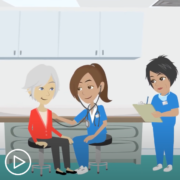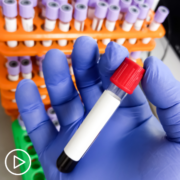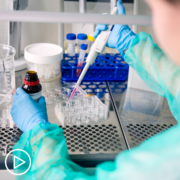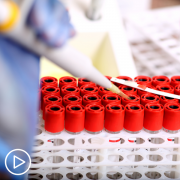Understanding Myeloma | How You Can Collaborate in Your Care
Understanding Myeloma | How You Can Collaborate in Your Care from Patient Empowerment Network on Vimeo.
This animated video reviews the types of myeloma, essential testing following a myeloma diagnosis, and advice for working with your healthcare team for the best overall care.
See More from Collaborate Myeloma
Related Resources:

|

|

|
Transcript:
Bianca:
Welcome back! I’m Bianca, and I’m a nurse. I specialize in caring for people with myeloma. And this is Suzanne, a myeloma patient advocate.
In this video, we are going to learn more about diagnosis and testing, and how test results may impact myeloma care.
Suzanne:
That’s right, Bianca. Most patients want to–and should– understand their diagnosis. Let’s start with the basics. Can you explain the different types of myeloma?
Bianca:
You bet. Let’s start with MGUS, which stands for monoclonal gammopathy of undetermined significance. MGUS typically has no signs or symptoms and is characterized by an abnormal protein in the blood or urine. This type of myeloma doesn’t require treatment but should be monitored regularly.
Smoldering myeloma is a very slow-growing type of myeloma. It also does not present with symptoms. Patients with smoldering myeloma have a higher chance of needing treatment, so blood and urine studies are ordered regularly.
And then there’s multiple myeloma, which is a buildup of plasma cells in the bone marrow that crowds out healthy cells, and causes symptoms and other problems in the body. Multiple myeloma requires treatment, and there are a number of approaches available.
Suzanne:
Thanks for explaining the difference. When I was initially diagnosed, I underwent a series of tests that included a blood test, bone marrow biopsy, urine test, and imaging.
Bianca:
Those are the standard tests when diagnosing myeloma. Your healthcare team should also order a more in-depth FISH test, which comes from the bone marrow biopsy sample, and FISH testing can provide a better understanding of your disease. This is important because the results may impact your treatment options.
Suzanne:
Right—and it’s important ensure that you have had all necessary testing including this more in-depth test. You should also review the lab results with your healthcare team. You can ask questions like:
- Am I high-risk or low-risk?
- What do the results mean?
- How will the results impact my options for therapy?
- And, how often should testing be repeated?
Bianca:
That’s good advice, Suzanne. All of the information gathered during your diagnosis, or following a relapse, should be considered as well as your overall health when deciding on a care plan.
And, as you’ve modeled, working with your healthcare team to make therapy choices is essential. This is a process called shared decision-making, which basically means that patients and their providers collaborate on healthcare decisions. Participating in this process encourages patients to engage in their care, helping them to feel more confident about the approaches they choose.
Suzanne:
That’s right! Working WITH my healthcare team makes me feel included and brings peace of mind when considering my options.
Bianca:
That’s the way it should be—you should always be at the center of your care. So, when considering a plan with your healthcare team, here are a few key steps:
- Start by understanding your diagnosis.
- Develop a good relationship with your healthcare team so that you can participate in your care.
- Ensure you have had all essential testing, including in-depth testing.
- Discuss the tests results with your doctor and ask questions about what they mean.
- And, as always, do research on your own and confirm what you’ve learned with your healthcare team.
Suzanne:
And don’t forget to visit powerfulpatients.org/myeloma to view more videos with Bianca and me. Thank you for joining us!


























